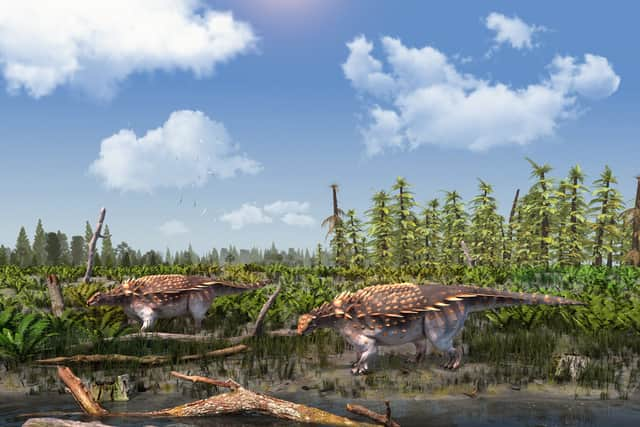New species of armoured dinosaur discovered in UK ‘for first time in 142 years’
and live on Freeview channel 276
An “important” and new species of dinosaur has been discovered on the Isle of Wight for the first time in 142 years.
The dinosaur has an armoured body and belongs to a group of plant-eating dinosaurs known as ankylosaur which are related to animals such as the Stegosaurus.
Advertisement
Hide AdAdvertisement
Hide AdIts remains were found in the island’s Wessex Formation – a fossil site dating back to somewhere between 145 to 66 million years ago.
It is the second armoured dinosaur to be found on the island after the first one, named Polacanthus foxii, was discovered in 1865.
The new species has been named Vectipelta barretti after Professor Paul Barrett who has worked at the Natural History Museum in London for 20 years and is an expert in herbivore dinosaurs.
His research has ranged from the origin of dinosaurs to how these animals diversified right up until their extinction 66 million years ago.
Advertisement
Hide AdAdvertisement
Hide Ad

Professor Barrett said he is “flattered and absolutely delighted to have been recognised in this way, not least as the first paper I ever wrote was also on an armoured dinosaur in the NHM collections.”
He added: “I’m sure that any physical resemblance is purely accidental.”
The new species, V barretti, differs from its predecessor P foxii in its neck and back bones. Both species have different pelvic structures and V barretti has a more blade-like spiked armour, according to the analysis.
Stuart Pond, a researcher at Natural History Museum’s Department of Earth Sciences, said: “For virtually 142 years, all ankylosaur remains from the Isle of Wight have been assigned to Polacanthus foxii, a famous dinosaur from the island, now all of those finds need to be revisited because we’ve described this new species.”
Advertisement
Hide AdAdvertisement
Hide AdAlthough both ankylosaurs originated from the same island the researchers found they were not very closely related.
They said instead the V barretti species is more closely related to some Chinese ankylosaurs which suggests these dinosaurs moved freely from Asia to Europe in the Early Cretaceous period (145 to 66 million years ago).
Mr Pond said the discovery of the new species is “important” because” it sheds light on ankylosaur diversity within the Wessex formation and Early Cretaceous England.”
The researchers said rocks from the Wessex Formation and the Isle of Wight are “hugely important” in understanding more about how dinosaurs went extinct.
On its website the Natural History Museum said the Isle of Wight “is one of the best places in Europe to find the remains of these ancient animals”.
Comment Guidelines
National World encourages reader discussion on our stories. User feedback, insights and back-and-forth exchanges add a rich layer of context to reporting. Please review our Community Guidelines before commenting.
